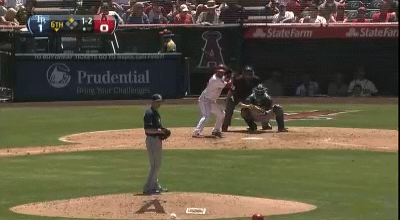Announcement
Collapse
No announcement yet.
Announcement
Collapse
No announcement yet.
A look into how Hellickson escapes danger
Collapse
X
-
some more thoughts on it from BP mechanics expert Doug Thornburn
Just an observation, but part of the explanation for his success with runners on could be mechanical.some gifs of what he was talking about
I feel that Hellickson has a better delivery from the stretch because he brings more momentum with runners on base, which acts to lengthen his release point – which means later relative pitch-break, giving batters less time to identify the incoming pitch.
Helix is slow to the plate from the windup [I gave him a 40 grade], but he often gets going with runners on [closer to a 50]. He uses a couple of strategies from the stretch, from a slide step to his standard leg lift, and though he does not get closer to the plate on the slide step (leg comes down too early), he does get noticeably closer to the plate when he uses a regular leg lift from the stretch due to the greater momentum. From what I have seen, he mostly relies on his regular leg lift from the stretch but mixes in the slide step to keep base-runners honest – so most of his pitches with runners on base have a deeper release point than his pitches from the windup.
Why Helix doesn’t use his stretch-momentum from the windup is somewhat perplexing, but he probably feels like he can repeat his timing more consistently with the slower motion.
from the windup

from the slidestep

from stretch max lift

-
Good stuff, thanks. I haven't read the fangraghs piece yet, but I wonder if pitchers with a high edge percentage also tend towards higher walk rates.
Have you considered how a fantasy owner might use edge percentage in his evaluations? If it does correlate with higher walk rates it might be worth the slightly higher whip for the higher LOB which would hopefully lead to better ERA.
Comment
-
Zimmerman touched on that http://www.fangraphs.com/fantasy/ind...-fantasy-tool/Originally posted by BigJonEmpire View Post
Have you considered how a fantasy owner might use edge percentage in his evaluations?
Comment
-
I was completely wrong. I'm not sure why but it actually seems that pitching on the edge of the zone correlates with lower walk rates.Originally posted by BigJonEmpire View PostGood stuff, thanks. I haven't read the fangraghs piece yet, but I wonder if pitchers with a high edge percentage also tend towards higher walk rates.
Have you considered how a fantasy owner might use edge percentage in his evaluations? If it does correlate with higher walk rates it might be worth the slightly higher whip for the higher LOB which would hopefully lead to better ERA.Last edited by BigJonEmpire; 01-21-2013, 12:23 PM.
Comment
-
entices the batter to swing and results in weaker contact. I'd be interested in the correlation to K's lookingOriginally posted by BigJonEmpire View PostI was completely wrong. I'm not sure why but it actually seems that pitching on the edge of the zone correlates with lower walk rates.
Comment

Comment